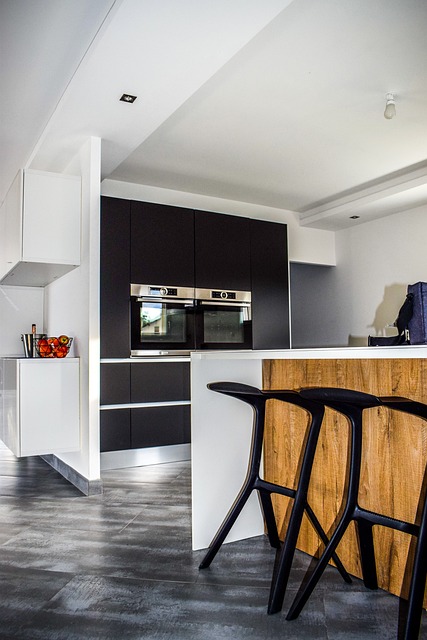When selecting kitchen flooring, consider traffic volume, budget, aesthetics, and eco-friendliness. Durable options like tile and hardwood are popular for their resistance to scratches and stains, with tile offering waterproof benefits. Hardwood requires regular sealing, while vinyl and laminate provide cost-effective, eco-friendly solutions. Modern kitchen floor materials cater to functional needs and environmental considerations, ensuring long-lasting, stylish floors resistant to common kitchen accidents.
Looking for a durable and stylish kitchen floor that can withstand spill-prone environments and easy cleaning? This guide explores the best water-resistant flooring options for family kitchens. From classic tile flooring to innovative eco-friendly materials like recycled vinyl and bamboo, we break down factors to consider, popular choices, installation tips, and maintenance guidance. Discover the perfect modern kitchen floor that combines beauty and functionality.
- Understanding Your Needs: Factors to Consider for Kitchen Flooring
- – Wear and tear from frequent use
- – Spill-prone environments and easy cleaning
- – Durability against moisture damage
Understanding Your Needs: Factors to Consider for Kitchen Flooring
When considering water-resistant flooring options for your family kitchen, it’s crucial to understand your specific needs and preferences. Factors such as traffic volume, budget, desired aesthetics, and eco-friendliness play a significant role in choosing the right kitchen flooring. High-traffic areas require durable materials like tile or vinyl that can withstand frequent cleaning and moisture exposure without damage. Budgeting is also essential; while hardwood floors offer elegance, they tend to be more expensive than laminate or vinyl options.
Modern kitchen floor materials should ideally balance functionality with style. Tile flooring, for instance, offers excellent waterproof protection and a wide array of designs, but it may require more maintenance. Hardwood floors exude natural beauty but need regular sealing to prevent water damage. Vinyl and laminate provide cost-effective, waterproof solutions, the latter being an eco-friendly option. Each material has its advantages, catering to different lifestyles and design preferences.
– Wear and tear from frequent use
In family kitchens, where wear and tear from frequent use is inevitable, choosing the right flooring option is paramount to ensure longevity and aesthetic appeal. Kitchen flooring options need to withstand not just everyday messes but also the constant foot traffic from bustling family activities. Durable kitchen flooring materials like tile and hardwood floors are popular choices due to their ability to resist scratches and stains over time. Tile flooring for kitchens offers both waterproof kitchen flooring benefits and a wide array of design possibilities, making it an excellent modern kitchen floor material. Hardwood kitchen floors, though more prone to damage, can be maintained with proper care, providing a classic and elegant look that never goes out of style.
For those seeking eco-friendly kitchen floors, vinyl and laminate kitchen flooring offer viable, cost-effective alternatives. Vinyl kitchen flooring is known for its water resistance and ease of maintenance, while laminate kitchen flooring mimics the appearance of hardwood at a fraction of the cost, without compromising durability. These options are ideal for families looking to balance style, functionality, and sustainability in their kitchens.
– Spill-prone environments and easy cleaning
In family kitchens, where spills and messes are common, choosing the right flooring is essential for maintaining a clean and inviting space. Opting for water-resistant or waterproof kitchen flooring options can greatly simplify cleaning routines. Modern kitchen floor materials that offer durability and ease of maintenance include tile and vinyl, both known for their ability to withstand liquid spills without absorbing moisture. Hardwood floors, though more prone to damage from water, can be protected with sealants and coatings, making them a popular choice among those seeking a natural, elegant look.
When it comes to eco-friendly kitchen floors, laminate flooring offers an affordable and durable alternative. It mimics the appearance of hardwood or tile without the environmental impact, as it’s made from compressed wood fibers. Vinyl flooring is another versatile option, providing not only water resistance but also insulation properties, which can be beneficial in colder climates. These durable kitchen flooring options not only cater to spill-prone environments but also contribute to a more sustainable home.
– Durability against moisture damage
When it comes to choosing kitchen flooring options, durability against moisture damage is a top priority for any family kitchen. Kitchens are often bustling hubs where accidents and spills are common, making waterproof kitchen flooring a must-have feature. Modern kitchen floor materials like tile flooring offer excellent resistance to water penetration, ensuring your floors remain in pristine condition even with frequent exposure to liquid splashes. Hardwood kitchen floors, while beautiful, require careful consideration as they can be susceptible to water damage. However, with proper sealing and maintenance, hardwood can also provide a durable and stylish option for your space.
Alternative materials like vinyl and laminate kitchen flooring are highly recommended for their waterproof properties and affordability. Vinyl kitchen flooring is particularly versatile, offering a range of designs that mimic the look of tile or hardwood while remaining impervious to water. Laminate kitchen flooring provides a cost-effective eco-friendly option with advanced waterproofing technology, making it an excellent choice for families seeking both style and durability without breaking the bank.
When choosing water-resistant flooring for your family kitchen, consider your unique needs and preferences. Whether you prioritize durability against moisture damage, easy cleaning, or a modern aesthetic, there’s an option to suit every style and budget. From tile and hardwood to vinyl and laminate, these materials offer both functionality and design appeal. Remember, selecting eco-friendly kitchen floors can also contribute to a healthier home environment without compromising on quality or aesthetics. Ultimately, the right flooring choice will enhance your kitchen’s beauty and resilience for years to come.
